
As you think about creating your own special fruit garden, pawpaw trees can play a big role in making it beautiful and healthy. These amazing trees not only produce tasty fruits but also work well with other plants. By planting pawpaws alongside different companion plants, you can improve the soil and bring more wildlife into your garden.
Imagine a colorful space where pawpaw trees stand tall, giving you yummy fruits and a lovely view. Thoughtful planning can help you design cozy spots in your garden that help everything grow together. Let’s dive into some fun ideas to celebrate National Pawpaw Day and make your fruit garden even more wonderful!
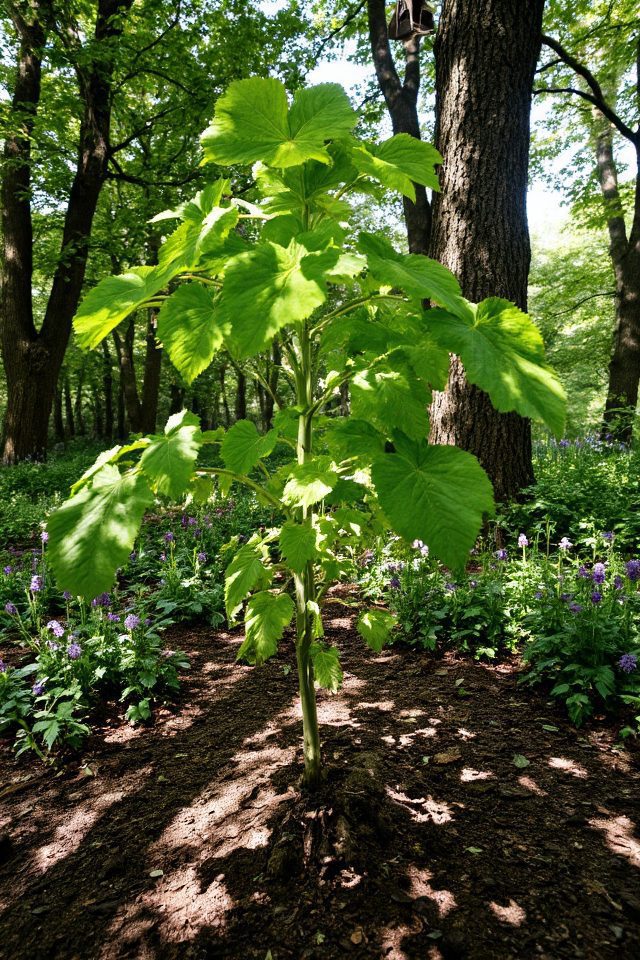
When selecting the right location for your pawpaw tree, consider factors such as sunlight, soil drainage, and protection from wind.
Pawpaw trees thrive in full to partial shade, ideally receiving at least four to six hours of direct sunlight daily.
Additionally, they prefer well-drained, rich soil that retains moisture without becoming waterlogged.
Planting near a natural windbreak or other trees can help protect young trees while they establish themselves and promote a healthy growing environment.
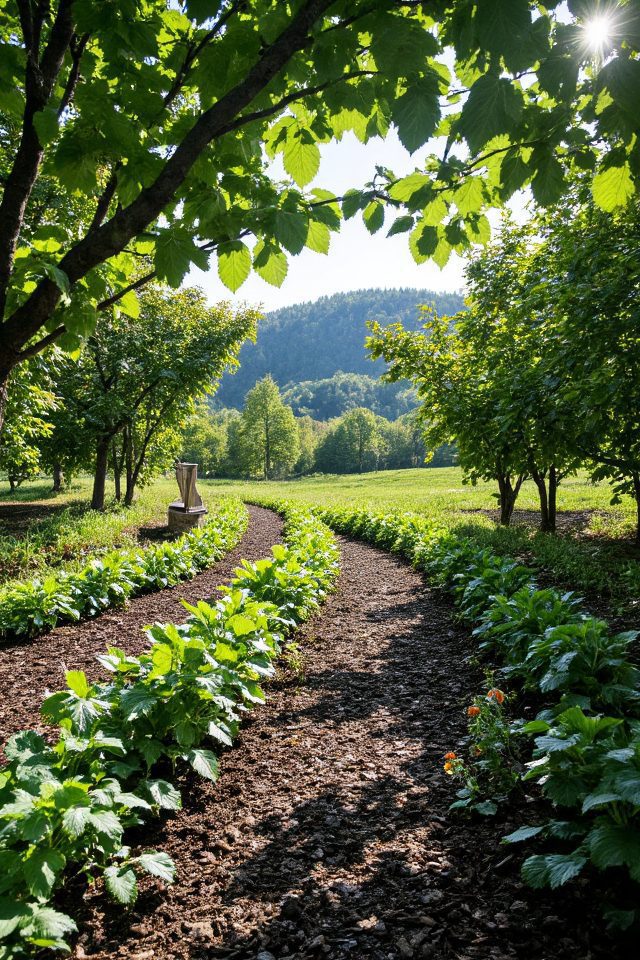
Creating a pawpaw orchard can be a rewarding and delicious endeavor. Start by selecting a sunny spot with well-drained soil, as pawpaw trees thrive in these conditions.
Plant your pawpaw saplings at least 10-15 feet apart to allow for their natural growth. Consider companion planting with plants that benefit from the shade of the trees.
Regular watering and mulching will help maintain moisture and suppress weeds.
With patience, you’ll enjoy the unique, custard-like fruit in a few years!
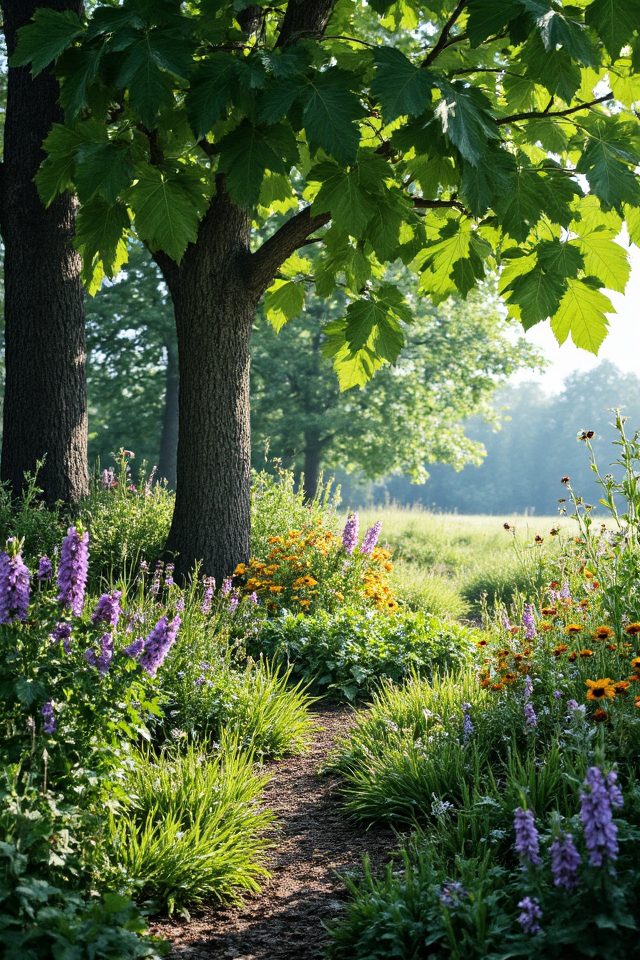
Incorporating pawpaw trees into a native pollinator garden is a fantastic way to enhance biodiversity while providing a habitat for local wildlife.
Pawpaw trees, known for their unique fruit and large, lush leaves, attract a variety of pollinators including bees and butterflies.
Planting them alongside native flowering plants creates a vibrant ecosystem, supporting both the trees and the pollinator populations.
This symbiotic relationship fosters a thriving garden, enriching your landscape while promoting conservation efforts.
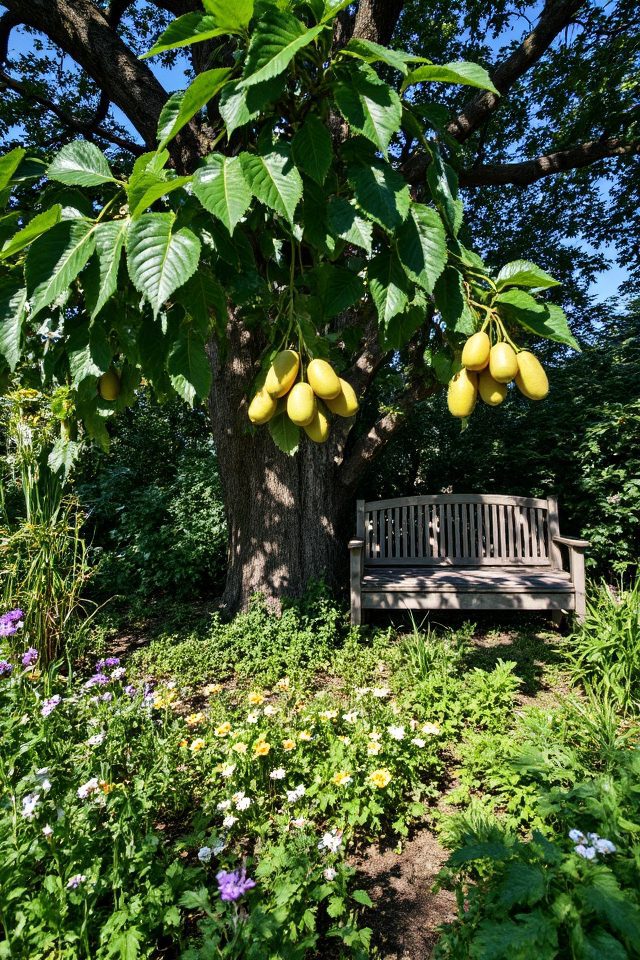
Using the pawpaw tree (Asimina triloba) as a focal point in your landscaping design can create a striking visual interest while offering unique benefits.
With its broad, lush leaves and large, custard-like fruits, the pawpaw not only provides shade but also adds a distinctive tropical flair to your yard.
Position it in a prominent area, surrounded by complementary plants, to enhance its aesthetic appeal.
Additionally, the pawpaw’s fragrant flowers and wildlife-friendly fruit attract pollinators and birds, enriching your garden’s ecosystem.
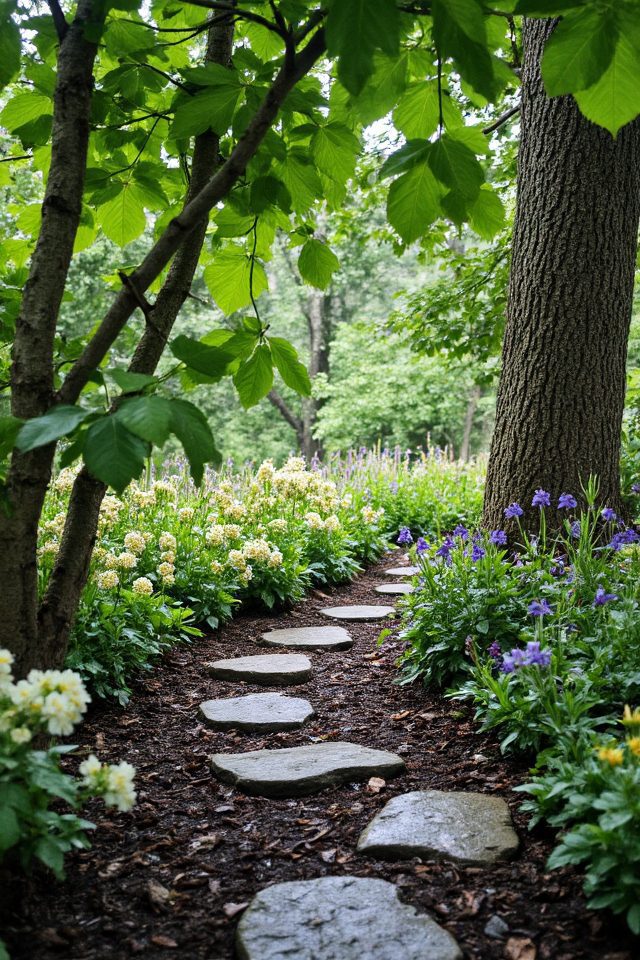
Planting pawpaws in rain gardens is a fantastic way to combine aesthetics with functionality.
These native trees thrive in moist, well-drained soil, making them ideal for rain gardens designed to manage stormwater runoff. Their large, tropical-looking leaves and beautiful, fragrant flowers add visual appeal, while the fruit provides a unique harvest.
Additionally, pawpaws attract pollinators, contributing to a vibrant ecosystem. Incorporating them in rain gardens not only enhances biodiversity but also aids in environmental sustainability.
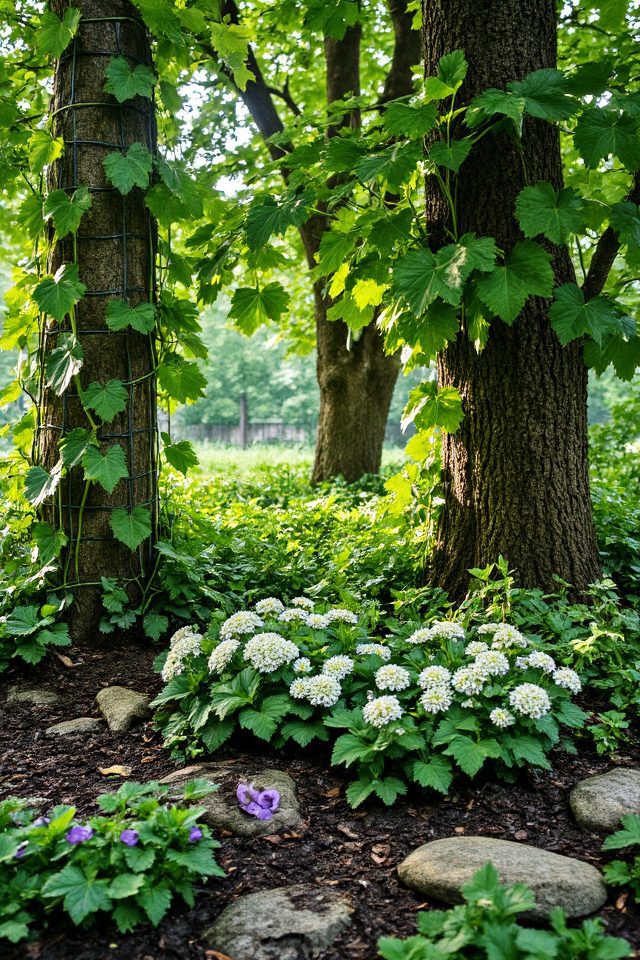
Designing companion planting with pawpaw trees can create a thriving ecosystem in your garden.
These native trees benefit from plants like comfrey and clover, which improve soil health and attract beneficial insects.
In contrast, avoiding allelopathic plants, such as black walnut, is essential as they can inhibit pawpaw growth.
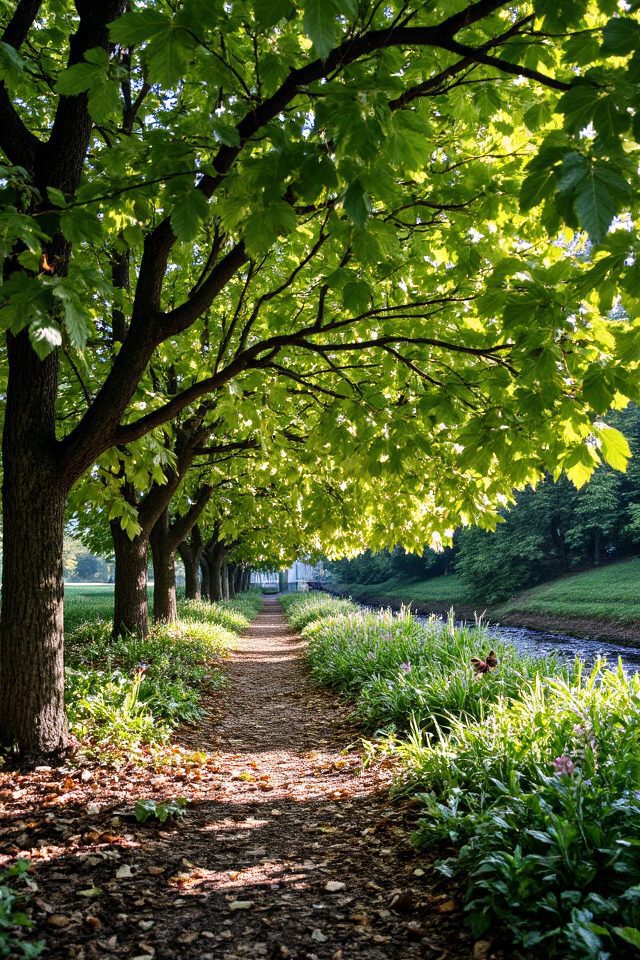
Creating a pawpaw tree hedge is an innovative way to enhance your landscape while providing a unique aesthetic and delicious fruit.
These small trees, known for their large, luscious fruits, can be planted in a row to form a natural boundary or privacy screen. They thrive in well-drained soil and partial shade, and their dense foliage can provide shelter for local wildlife.
Plus, the pawpaw’s seasonal blooms and vibrant leaves add beauty throughout the year, making it a valuable addition to any garden.
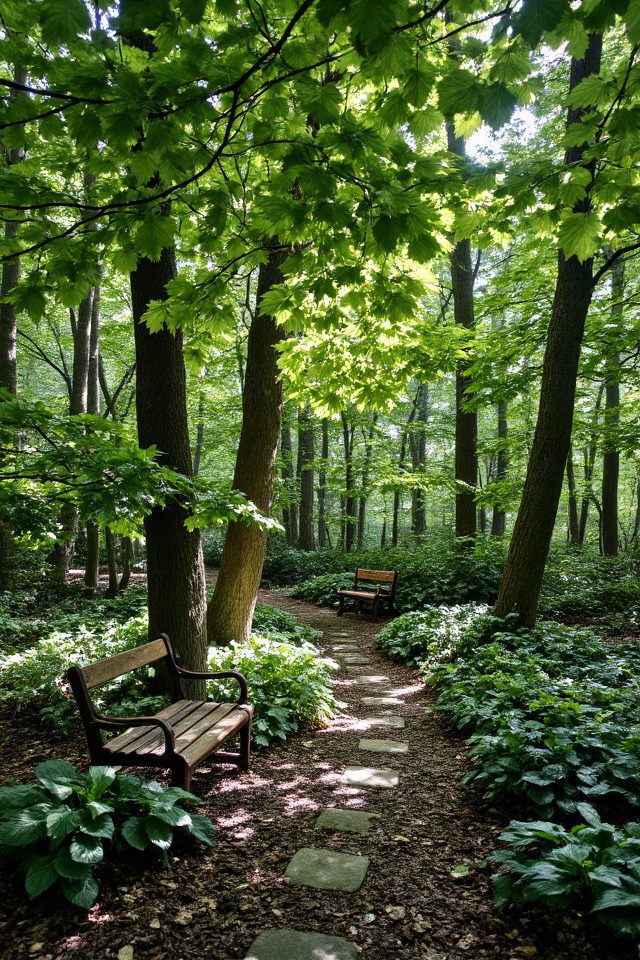
Creating a woodland garden featuring pawpaws offers a unique way to celebrate this native fruit tree.
These shade-loving trees thrive in understory environments, providing both beauty and bounty.
Surround them with ferns, hostas, and other native plants to enhance the natural look while ensuring proper drainage and soil moisture.
Incorporate paths and seating areas to invite visitors to enjoy the serene atmosphere, making it a perfect spot for relaxation and connection with nature.
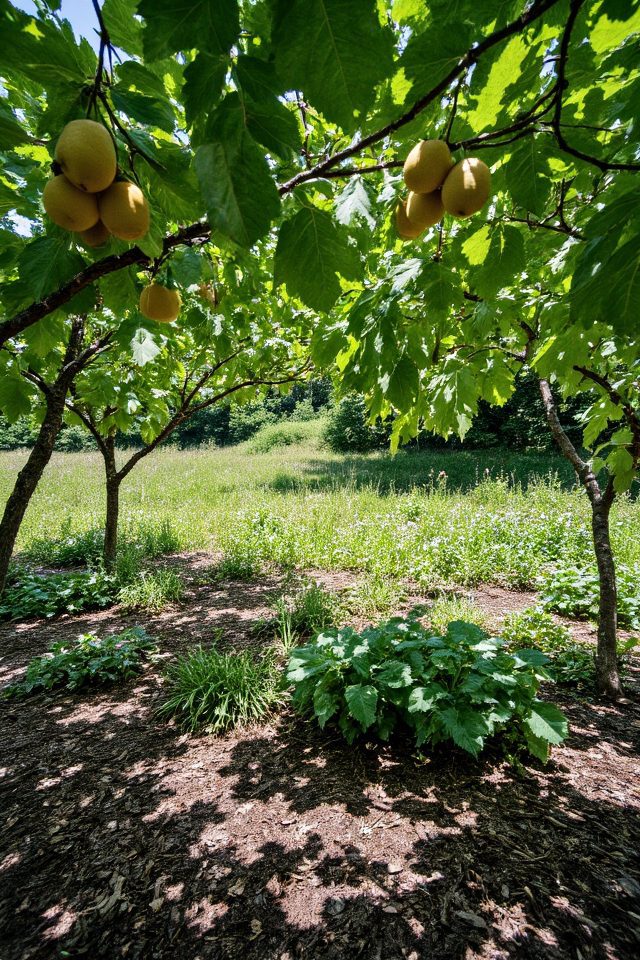
Incorporating pawpaw trees into edible landscapes offers a unique way to blend aesthetics with functionality.
These native fruit trees not only thrive in various soil types but also produce delicious, custard-like fruits that are rich in nutrients.
Strategically planting pawpaw near other fruiting plants can enhance biodiversity and create a lush, productive environment.
Their large leaves provide shade and habitat for beneficial insects, making them a perfect addition to sustainable gardens focused on food production.
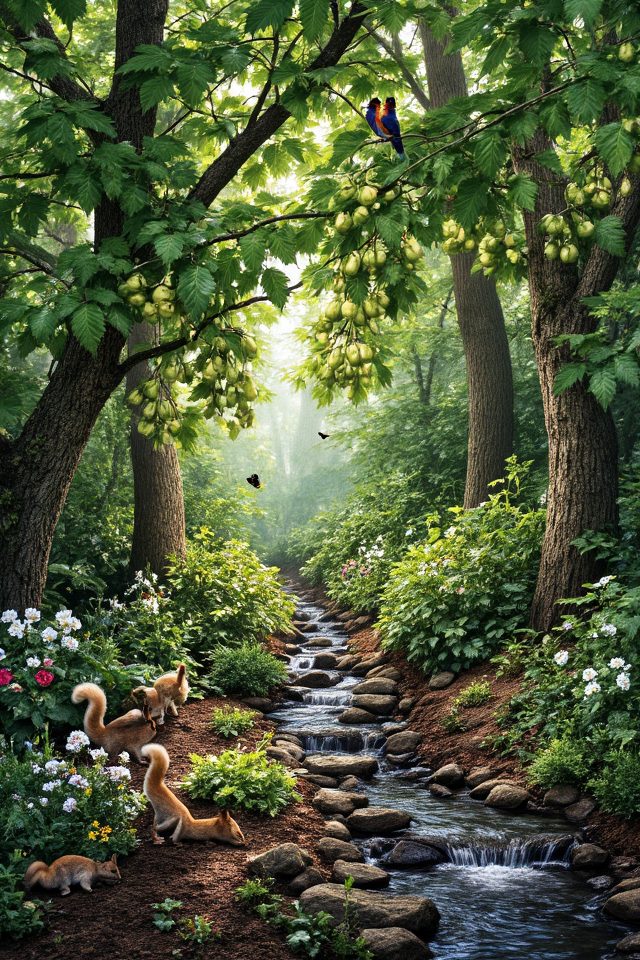
Incorporating pawpaw trees into wildlife gardens can create a serene and productive habitat for various species.
Pawpaw trees attract pollinators like bees and butterflies with their fragrant flowers, while their nutrient-rich fruits provide food for birds and mammals.
Planting these trees alongside native shrubs and perennials enhances biodiversity, creating a thriving ecosystem.
Their large, tropical leaves also offer shade and shelter, making them an essential addition for wildlife seeking refuge in the garden.
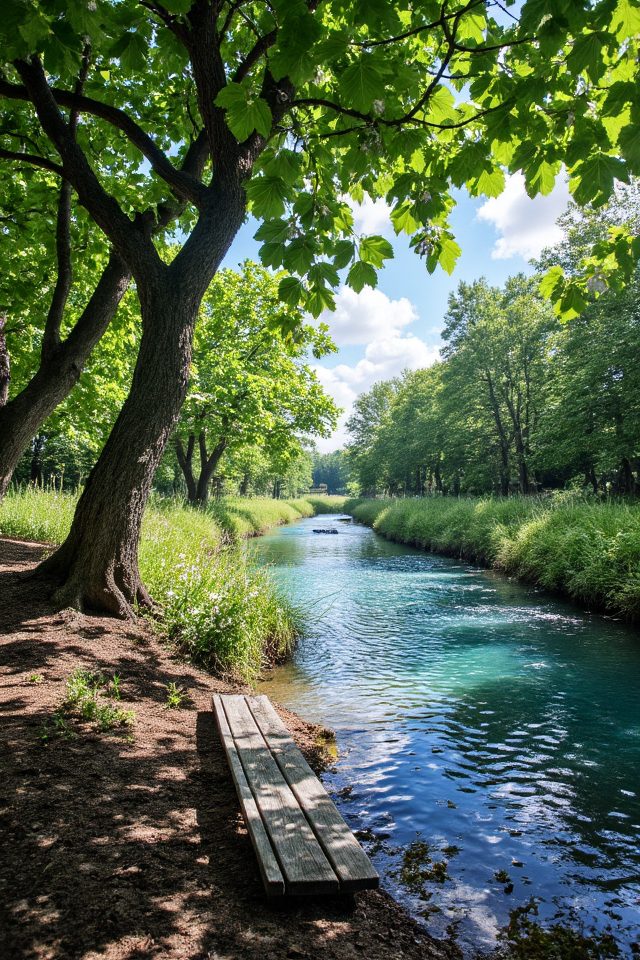
Planting pawpaw trees near water features can create a serene and harmonious landscape. Their broad, tropical-looking leaves provide lush greenery, while their fragrant flowers attract pollinators.
The moist environment near ponds or streams mimics their natural habitat, promoting healthy growth and fruit production. Plus, the contrast of the pawpaw’s vibrant green foliage against the shimmering water adds visual interest.
Incorporating pawpaw trees into these areas not only enhances aesthetics but also supports local wildlife.
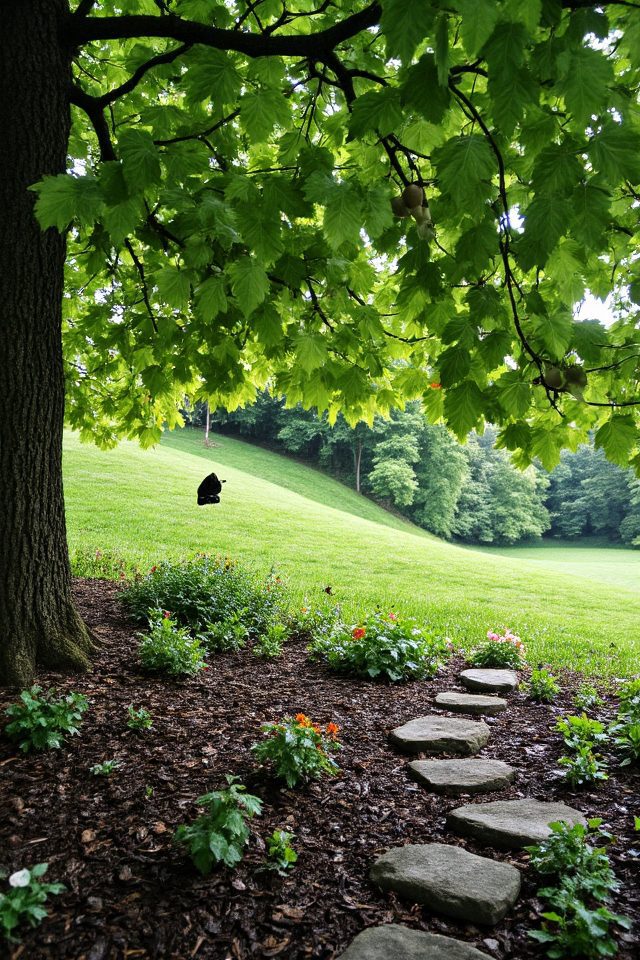
Creating a shade garden with pawpaw trees is an excellent way to enhance your landscape while benefiting from their unique attributes.
Pawpaw trees thrive in partial to full shade and are relatively easy to grow, making them ideal for a tranquil garden setting. Their large, heart-shaped leaves provide an inviting canopy, while the trees blossom with fragrant flowers in spring.
Additionally, the delicious, custard-like fruit in the fall adds both visual interest and culinary flavor to your garden space.

Enhancing seating areas with pawpaw canopies adds both style and shade to your landscape.
The pawpaw tree, known for its large, lush leaves, provides a natural umbrella that creates a cool and inviting atmosphere.
Position seating beneath these canopies to create cozy nooks for relaxation or social gatherings.
Additionally, the distinctive fruits of the pawpaw tree can attract wildlife and enhance the visual appeal of your outdoor space, making it a delightful retreat.
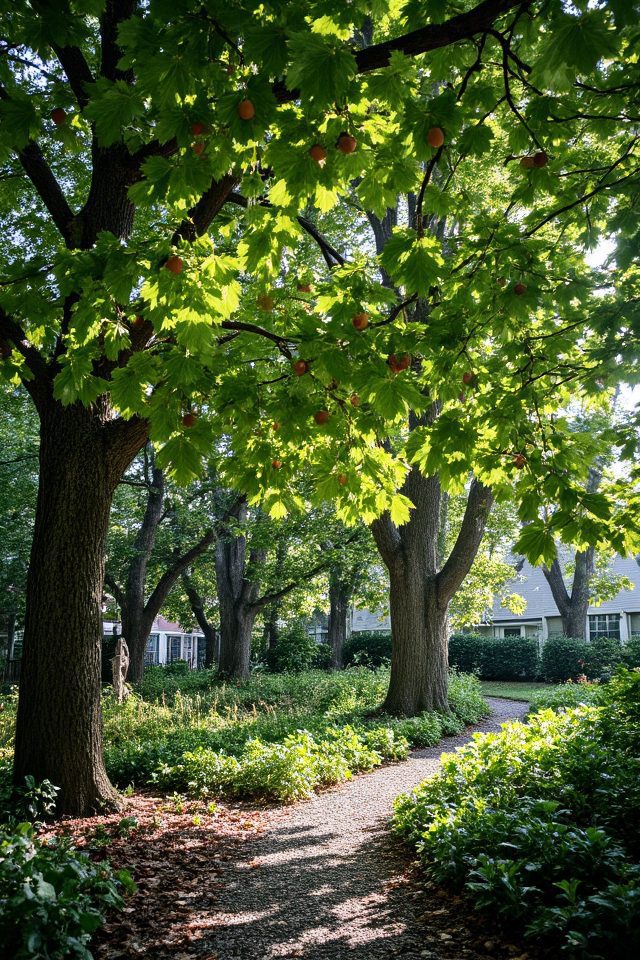
Using pawpaw trees as a natural privacy screen is an excellent landscaping idea that combines aesthetic appeal with functionality.
Their lush, broad leaves create a dense canopy that not only blocks sight lines but also provides dappled shade. The pawpaw’s height can reach 10-40 feet, making it an effective barrier against neighbors and street views.
Additionally, these trees produce unique, delicious fruit, adding an edible element to your landscape while enhancing your outdoor privacy.
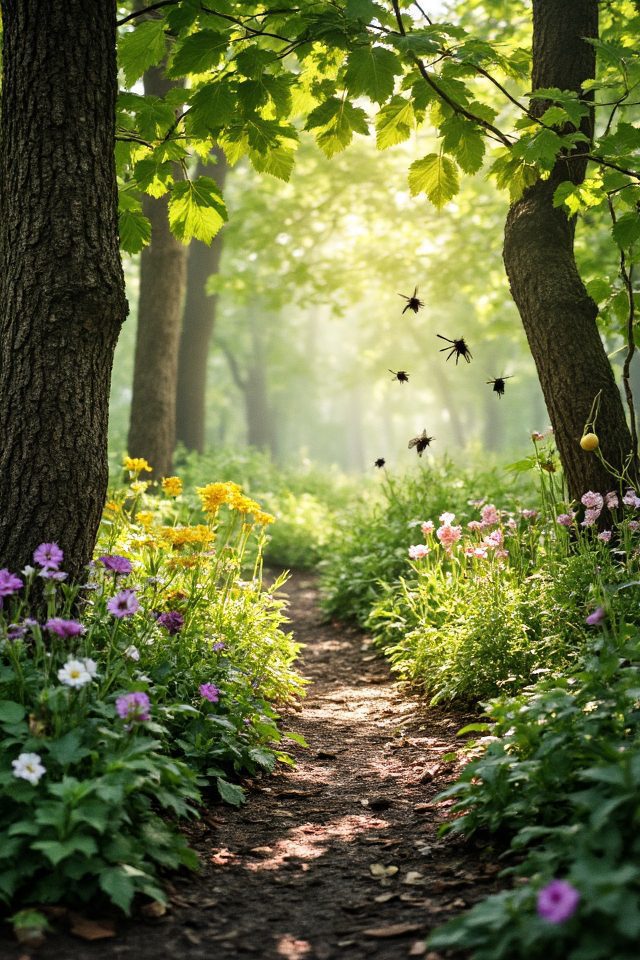
Creating a Pawpaw Pollinator Path is an excellent way to enhance your garden while supporting local biodiversity.
This path can be lined with pawpaw trees, which attract key pollinators like bees and butterflies. By incorporating native flowering plants alongside, you’ll offer a continuous source of nectar throughout the growing season.
Not only will this promote a healthy ecosystem, but it will also guarantee a fruitful pawpaw harvest, as pollinators are essential for the tree’s reproduction.

Potting up pawpaws for container gardens is an excellent way to enjoy these unique fruit trees even in limited space.
Choose a large, sturdy pot with good drainage to accommodate their extensive root systems. Use a rich, well-draining potting mix and guarantee adequate sunlight exposure for ideal growth.
Regular watering and fertilization will promote healthy development.
Container gardening allows for easy mobility, so you can move your pawpaw plants to take advantage of seasonal changes.
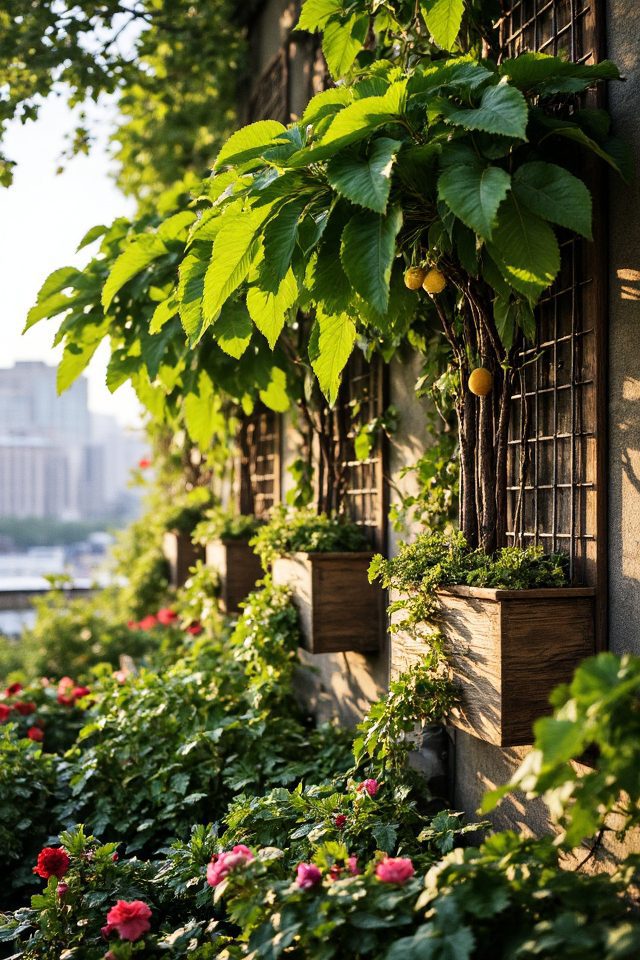
Incorporating pawpaw trees into vertical gardens creates a unique and productive landscaping feature.
These small, tropical trees thrive in various climates and offer delicious, custard-like fruits. By utilizing trellises or wall-mounted planters, gardeners can maximize space while showcasing the tree’s lush foliage.
This not only enhances aesthetics but also supports biodiversity by attracting pollinators. Positioning pawpaw trees vertically allows for easier maintenance and harvesting, making them an ideal choice for urban gardening enthusiasts.
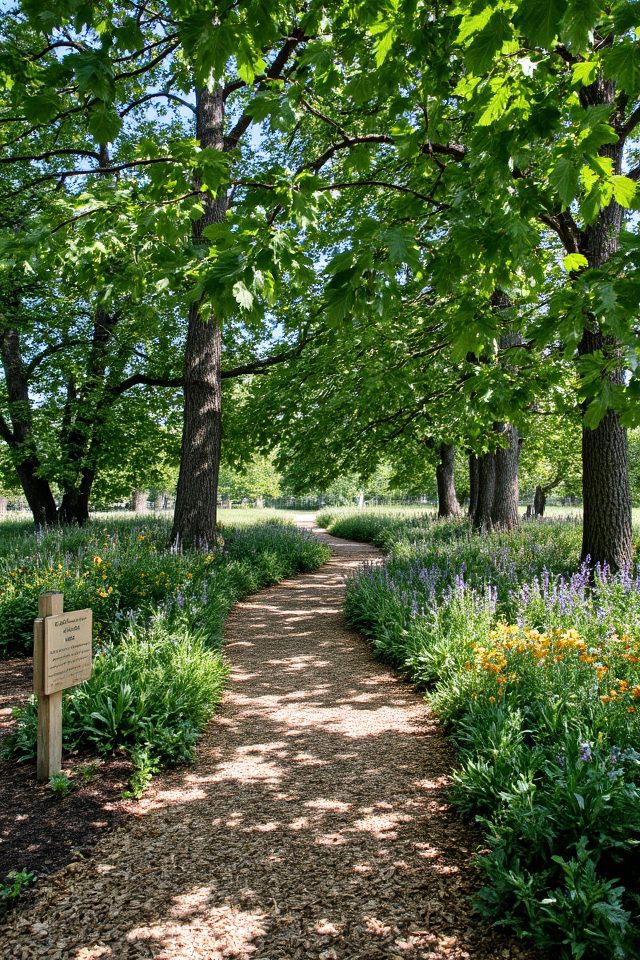
Create a themed Pawpaw fruit trail in your garden to celebrate this unique North American fruit.
Start by planting pawpaw trees in a designated area, ensuring they receive ample sunlight and protection from strong winds. Along the path, incorporate informative signs about the pawpaw’s growth, history, and culinary uses.
Consider adding colorful native plants and seating areas to enhance the atmosphere.
This trail can serve as an educational journey for visitors while showcasing the beauty of the pawpaw.
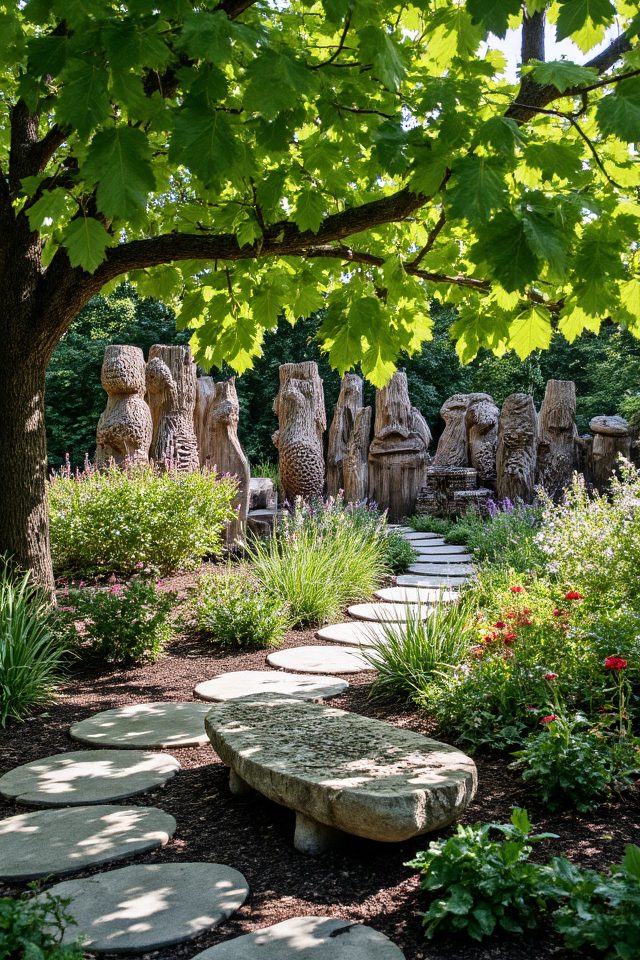
Incorporating pawpaw trees into landscape art installations offers a unique blend of beauty and functionality. Their large, tropical-looking leaves and stunning flowers can serve as a focal point in gardens and parks, while the fruit provides an unexpected edible element.
Art installations can creatively use the shape and form of the pawpaw, integrating it into sculptures or garden walls. This approach not only enhances the aesthetic appeal but also promotes biodiversity and sustainable practices in landscaping.
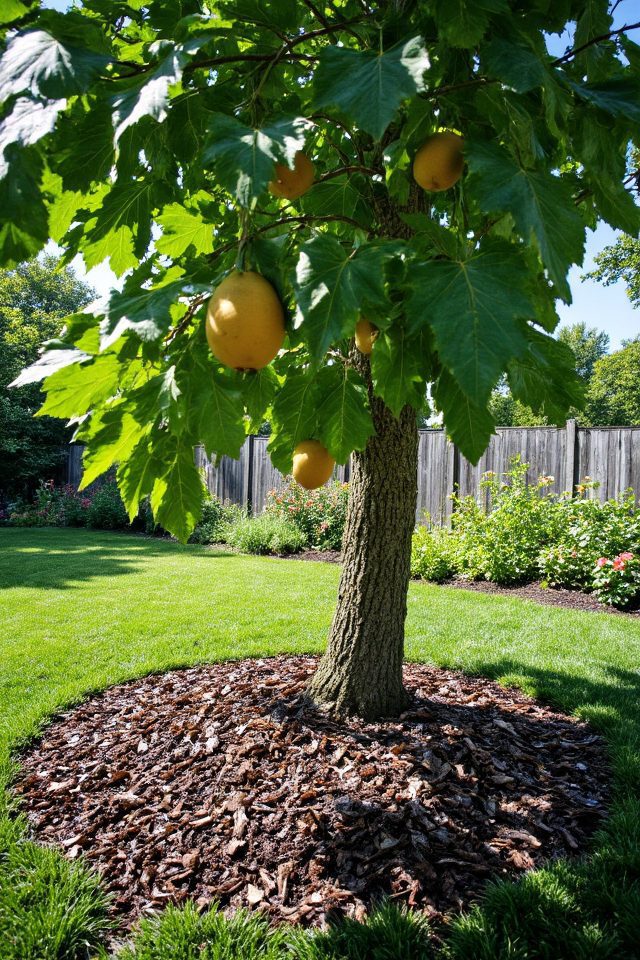
Adding mulch around your pawpaw tree is an effective strategy for moisture retention. A 2-4 inch layer of organic mulch, such as wood chips or shredded leaves, helps regulate soil temperature, prevent weeds, and reduce evaporation.
This protective barrier not only keeps the soil consistently moist but also enriches it as the mulch decomposes, promoting healthy root development.
Regularly replenishing the mulch guarantees your pawpaw tree stays hydrated and thriving throughout the growing season.
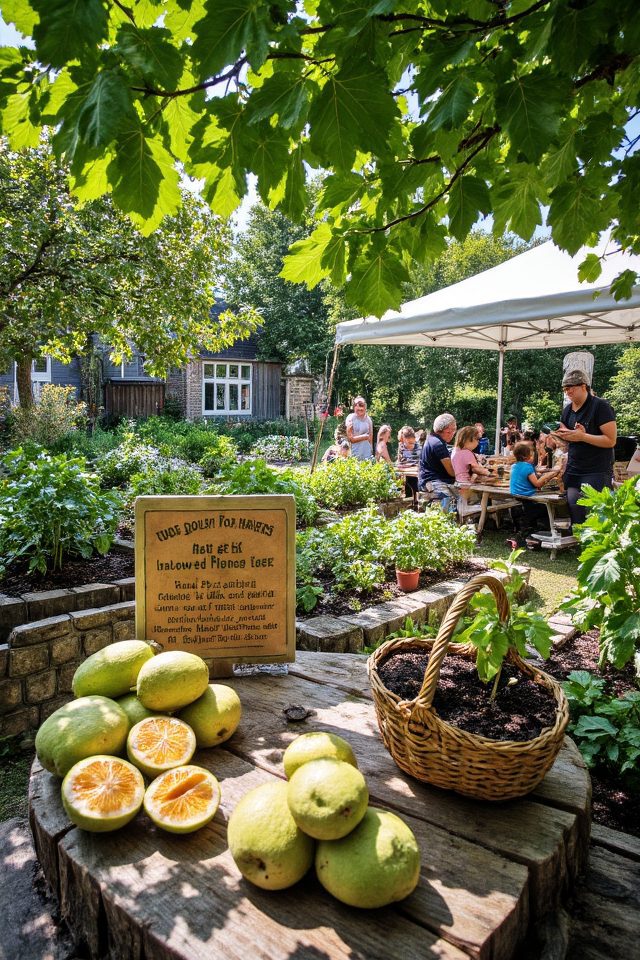
National Pawpaw Day, celebrated on the third Saturday in September, is the perfect occasion to host garden events that highlight this unique fruit.
Organize activities such as pawpaw tasting stations, informative workshops on how to grow and care for pawpaw trees, and fun family-friendly games.
Creating a community atmosphere around this native fruit not only fosters appreciation for pawpaws but also encourages participants to explore sustainable gardening practices.
Celebrate by promoting local biodiversity and sharing pawpaw recipes!
By integrating pawpaw trees into your landscape, you’re not just enriching your garden, but also celebrating the spirit of nature’s diversity. Whether you’re creating a vibrant orchard, a pollinator haven, or a thematic pathway, these ideas will help you cultivate a thriving ecosystem. Don’t forget to host garden events for National Pawpaw Day, fostering community appreciation for this remarkable fruit. Embrace these strategies to transform your native fruit garden into a lush, inviting paradise!

Don't let aphids, slugs, and caterpillars ruin another plant. Take back control with simple, natural methods that actually work.